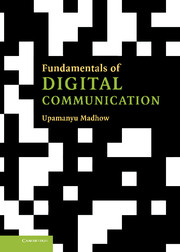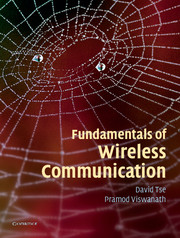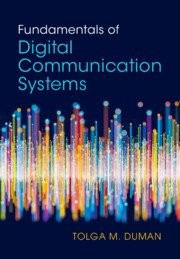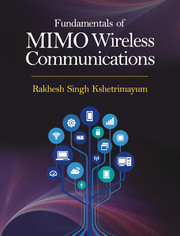Refine search
Actions for selected content:
119793 results for communication fundamentals
Title match
Part 1 - Communication fundamentals
-
- Book:
- Signal Processing and Optimization for Transceiver Systems
- Published online:
- 05 August 2011
- Print publication:
- 11 March 2010, pp -
-
- Chapter
- Export citation

Fundamentals of Digital Communication
-
- Published online:
- 05 June 2012
- Print publication:
- 06 March 2008
2 - Fundamentals of Magnetic Communications
- from Part I - Introduction and Properties of MI
-
- Book:
- Magnetic Communications
- Published online:
- 04 January 2024
- Print publication:
- 18 January 2024, pp 28-40
-
- Chapter
- Export citation
4 - Wireless communications fundamentals
-
- Book:
- Adaptive Wireless Communications
- Published online:
- 05 May 2013
- Print publication:
- 09 May 2013, pp 118-140
-
- Chapter
- Export citation
1 - Fundamentals of Digital Communications
-
- Book:
- Introduction to Digital Communications
- Published online:
- 24 April 2023
- Print publication:
- 16 March 2023, pp 1-45
-
- Chapter
- Export citation
3 - Fundamental Limits on Communications
- from Part I - Communications Systems
-
- Book:
- Modern Communications
- Published online:
- 18 August 2021
- Print publication:
- 22 July 2021, pp 31-50
-
- Chapter
- Export citation
PART I - FUNDAMENTALS OF WIRELESS COMMUNICATION
-
- Book:
- Wireless Communication
- Published online:
- 21 July 2025
- Print publication:
- 16 January 2017, pp 35-36
-
- Chapter
- Export citation

Fundamentals of Wireless Communication
-
- Published online:
- 05 June 2012
- Print publication:
- 26 May 2005
2 - Fundamentals of Ambient Backscatter Communication
- from Part I - Fundamentals of Ambient Backscatter Communication
-
- Book:
- Ambient Backscatter Communication Networks
- Published online:
- 24 April 2020
- Print publication:
- 30 April 2020, pp 33-61
-
- Chapter
- Export citation
Part I - Fundamentals of Ambient Backscatter Communication
-
- Book:
- Ambient Backscatter Communication Networks
- Published online:
- 24 April 2020
- Print publication:
- 30 April 2020, pp 1-2
-
- Chapter
- Export citation
1 - A Fundamental Change in Political Communication
-
- Book:
- Frenemies
- Published online:
- 17 August 2018
- Print publication:
- 30 August 2018, pp 1-19
-
- Chapter
-
- You have access
- HTML
- Export citation

Fundamentals of Digital Communication Systems
-
- Published online:
- 10 March 2025
- Print publication:
- 23 January 2025
-
- Textbook
- Export citation

Fundamentals of MIMO Wireless Communications
-
- Published online:
- 23 July 2017
- Print publication:
- 17 April 2017
3 - Backscatter Communications: Fundamentals and Recent Advances
-
- Book:
- Radio Frequency Identification Engineering
- Published online:
- 02 January 2025
- Print publication:
- 09 January 2025, pp 42-76
-
- Chapter
- Export citation
6 - Protecting fundamental rights within the Community
-
- Book:
- Essential Questions in EU Law
- Published online:
- 05 June 2012
- Print publication:
- 11 June 2009, pp 88-105
-
- Chapter
- Export citation
Seven fundamental rethinking for next-generation wireless communications
-
- Journal:
- APSIPA Transactions on Signal and Information Processing / Volume 6 / 2017
- Published online by Cambridge University Press:
- 20 September 2017, e10
- Print publication:
- 2017
-
- Article
-
- You have access
- Open access
- HTML
- Export citation
“Praying for a Wicked City”: Congregation, Community, and the Suburbanization of Fundamentalism
-
- Journal:
- Religion and American Culture / Volume 13 / Issue 2 / Summer 2003
- Published online by Cambridge University Press:
- 18 June 2018, pp. 167-203
- Print publication:
- Summer 2003
-
- Article
- Export citation
Re Accession of the European Community to the Convention for the Protection of Human Rights and Fundamental Freedoms
- Court of Justice of the European Communities. 28 March 1996
-
- Journal:
- International Law Reports / Volume 108 / 1998
- Published online by Cambridge University Press:
- 01 January 2021, pp. 225-256
- Print publication:
- 1998
-
- Article
- Export citation
Community Terrorism Listings Fundamental rights, and UN Security Council Resolutions: In Search of the right fit
-
- Journal:
- European Constitutional Law Review / Volume 3 / Issue 2 / June 2007
- Published online by Cambridge University Press:
- 14 August 2007, pp. 183-206
-
- Article
-
- You have access
- Export citation
GENOCIDE CASES BEFORE THE INTERNATIONAL COURT: COMMUNITY ACTION TO ENFORCE FUNDAMENTAL NORMS
-
- Journal:
- The Cambridge Law Journal / Volume 83 / Issue 2 / July 2024
- Published online by Cambridge University Press:
- 24 October 2024, pp. 199-205
- Print publication:
- July 2024
-
- Article
-
- You have access
- Open access
- HTML
- Export citation
